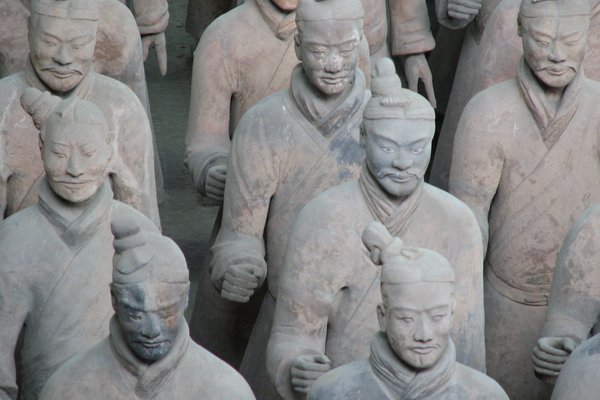China
Mausoleum of the First Qin Emperor
The Mausoleum of the First Qin Emperor is known for its life-size terracotta statues of warriors.
The hyperrealistic sculptures are seen as major works in the history of Chinese sculpture and are valuable for the insight they provide into the social and military history of the period. Qin Shi Huang in 246 BCE arranged for this burial site for himself. The Terracotta Army was to be buried with him to help him rule another empire in the afterlife. The three main pits have uncovered over 8,000 figures of warriors and horses and a large number of exquisite funeral objects.
Community Perspective: “The longer you spend around the warriors the more impressed you become.”
Site Info
Official Information
- Full Name
- Mausoleum of the First Qin Emperor (ID: 441)
- Country
- China
- Status
-
Inscribed 1987
Site history
History of Mausoleum of the First Qin Emperor
- 1987: Inscribed
- Inscribed
- Type
- Cultural
- Criteria
- i
- iii
- iv
- vi
Links
- UNESCO
- whc.unesco.org
- Official
-
- bmy.com.cn — Emperor Qinshihuang's Mausoleum Site Museum
- Related
-
- travelchinaguide.com — Travel China GuideMuseum of the Terracotta Army
All Links
UNESCO.org
- whc.unesco.org — whc.unesco.org/
Official Website
- bmy.com.cn — Emperor Qinshihuang's Mausoleum Site Museum
Related Resources
- travelchinaguide.com — Travel China GuideMuseum of the Terracotta Army
News Article
- May 31, 2025 theguardian.com — Tourist damages two of China’s terracotta warriors after jumping fence
- April 23, 2017 news.xinhuanet.com — Facelift of China's major museum to raise bronze chariots above ground
- May 6, 2015 news.com.au — Excavations reveal new terracotta army
- Nov. 15, 2014 news.nationalgeographic.com — Ears of Ancient Chinese Terra-Cotta Warriors Offer Clues to Their Creation
- Dec. 19, 2013 globaltimes.cn — Qin armor unearthed at Terracotta site
- June 13, 2012 ibtimes.co.uk — More than 100 New Terracotta Warriors of Qin Dynasty Unearthed
- Dec. 3, 2011 foxnews.com — New Research Casts Doubt on China's Terracotta Warriors' Roles
- Sept. 10, 2010 chinadaily.com.cn — Terracotta army emerges in its true colors
- Sept. 8, 2009 theartnewspaper.com — Terracotta Army Museum denies major discovery of 100 new terracotta warriors
- July 18, 2009 news.xinhuanet.com — Archeologists report new findings at terracotta army site
- June 13, 2009 upi.com — Third phase of excavation to begin on the largest of three pits containing the terra cotta army in Xian
- May 31, 2008 english.people.com.cn — Seven terracotta warriors and horses suffered slight damage in the May 12 earthquake
Community Information
- Community Category
- Secular structure: Burial
Travel Information
One million visitors or more
Luoyang Hotspot
Bullet train and bus should be feasible in a day
Recent Connections
-
Luoyang Hotspot
Bullet train and bus should be feasibl…
-
Incorrect UNESCO 'Number of locations'
No locations listed at all, but the rev…
-
Perfect Inscriptions
1987
Connections of Mausoleum of the First Qin Emperor
- Geography
-
-
Antipodes points
SEWELL MINING TOWN=MAUSOLEUM OF THE FIRST QIN EMPEROR S34 05 04 W70 22 58 = N34 22 60 E109 5 60 -
Yellow River Basin
Situated south of the Wei river, a major tributary of the Yellow River
-
- Trivia
-
-
In Video Games
Qin: Tomb of the Middle Kingdom; Civilization VI: Terracotta Army; Civilization VII: Terracotta Army -
One million visitors or more
received 11 million visitors in 2023, hitting a record-high number since its opening // In 2015, over 5 million people visited the site -
Total Solar Eclipse since Inscription
1 August, 2008 -
Former Largest Cities
Chang’an (Xi’an) had around 400,000 inhabitants between 200 and 100 BC -
On Passports
Chinese passport: Shaanxi -> Terracotta Warriors
-
- History
-
-
Located in a Former Capital
Xi'an (Chang'an) several times
-
- Ecology
-
-
Liquid Mercury
The actual tomb has not yet been excavated but is believed to contain an underground "Palace". An account of the construction of the mausoleum and its description was created by the Chinese Historian Sima Qian (c145BC - 86BC) in his "Records of the Grand Historian" (Shi ji), which contains the biography of Qin Shi Huang (Chapter 6), This states that "Mercury was used to simulate the hundred rivers, the Yangtze and Yellow River, and the great sea, and set to flow mechanically". Whether this was the case remains unproven. Various attempts have been made, however, to identify what might be inside via soil analyses, sonar etc and these claim to have discovered indications of a large chamber whose overlaying soil contains anomalously high levels of Mercury
-
- World Heritage Process
-
-
Incorrect UNESCO 'Number of locations'
No locations listed at all, but the revised map from 2014 clearly shows 2 different areas.
-
Perfect Inscriptions
1987
-
- Religion and Belief
-
-
Horse Burials
"Almost one hundred pits containing the skeletons of horses and terracotta grooms constituted the emperor's stables. Even hay was provided." See "Stable Pits" under
-
- Human Activity
-
-
Chariots
Ca. 130 chariots were buried together with the soldiers
-
- Constructions
-
-
Protective Shelters
Complete buildings safeguard the Terracotta Warriers -
Pyramids
See en.wikipedia.org
-
Mausolea
-
- Timeline
-
-
Built in the 3rd century BC
"The figures, dating from 3rd century BC, were discovered in 1974 by some local farmers in Lintong District, Xi'an, Shaanxi province, near the Mausoleum of the First Qin Emperor Qin Shi Huang)." - wiki
-
- WHS Hotspots
-
-
Luoyang Hotspot
Bullet train and bus should be feasible in a day
-
- Science and Technology
-
-
Archaeological potential
"No doubt thousands of statues still remain to be unearthed at this archaeological site" -
Recently discovered
Discovered by some peasants working in a field in 1974
-
- WHS Names
-
-
Microcosm
"... is a microcosm of the Zhongguo (Middle Country) that Qin Shi Huang wanted both to unify (he imposed throughout the land a single system of writing, money, weights and measures) and to protect from the barbarians that could arrive from any direction (the army which watches over the dead emperor faces outward from the tomb)."(OUV)
-
- Literature & Film
-
-
Featured in the Go Jetters
Series 2: Episode 18: Terracotta Army, China
-
News
- theguardian.com 05/31/2025
- Tourist damages two of China’s ter…
- news.xinhuanet.com 04/23/2017
- Facelift of China's major museum t…
- news.com.au 05/06/2015
- Excavations reveal new terracotta …
Recent Visitors
Visitors of Mausoleum of the First Qin Emperor
- Adrian Turtschi
- Afshin Iranpour
- Alejandro Lau
- Alexander Barabanov
- Alexander Lehmann
- Alexander Parsons
- Alex Goh
- Alex Marcean
- Alikander99
- Ali Zingstra
- ALS
- A. Mehmet Haksever
- Ammon Watkins
- Ana Lozano
- Ansitong
- anthonybonbon
- Antonio J.
- Artur Anuszewski
- Atila Ege
- AustralLights
- Bamse
- Bill Koo
- Bill Maurmann
- Bin
- Boj
- Bundi Cao
- Carl Le Boeuf
- Carlo Sarion
- CeeCeeSR
- Chalamphol Therakul
- Chantal den Haan
- chenboada
- chenqtao
- Cheryl
- chiuliqi
- christof
- Christravelblog
- Claire Bradshaw
- Clyde
- Col
- Colossus
- Corinne Vail
- cwthong
- CynthiaW
- czesioszpachelka
- Daniela Hohmann
- dave wood
- David Marton
- Deffra
- Delphine Delaunay
- Dennis Nicklaus
- Dimitar Krastev
- dmux7
- Dolemite92
- Dorejd
- Dwight Zehuan Xiao
- Echwel
- Elisabeth Fransisca Situmorang
- Els Slots
- Eric Lurio
- Erik Jelinek
- Eva Kisgyorgy
- Fan Yibo
- Federico P.
- Felicité
- Fernweh
- finsbury_jo
- FK
- Frederik Dawson
- Garrett
- Geert Luiken
- George Gdanski
- GeorgeIng61
- giloudepuertorico
- giulio25
- Hadrianus
- HaraldOest
- Harald T.
- H Beswick
- henryjiao18
- heywhatever2
- Iain Jackson
- Ingrid
- Jacob Choi
- Jacob Otten
- Jan Zimmermann
- Javier
- Javier Coro
- jballard650
- Jeanne OGrady
- Jeffrey Chai
- Jens
- Joel on the Road
- Jonas Hagung
- Jonas Kremer
- jonathanfr
- Jon Eshuijs
- JoStof
- Joyce van Soest
- Juha Sjoeblom
- jxrocky
- KarenBMoore
- Kasper
- Ken DJ
- Kerékgyártó
- Kevin McFarland
- Kjlauer
- KngAlaric
- Knut
- KoenigMarke
- Kristin
- Krzysztof B
- Kurt Lauer
- kutasp
- Kyle Magnuson
- Lameduck99
- Li
- Liamps91
- lichia
- Lillybett
- Lucio
- Ludvan
- Luis Filipe Gaspar
- Luke LOU
- lynnz317@aol.com
- Maciej Gil
- Maciej Gowin
- Maja
- Malgorzata Kopczynska
- Marcobrey
- Mariam
- maryhattie
- Matthewrw
- Matthewsharris
- MaYumin
- MC
- MichaelH
- Michael Novins
- Mihai Dascalu
- Mikko
- Miloš Tašković
- Mo-han Je
- Monica66
- Monica Tasciotti
- Morodhi
- Naim Y
- nan
- Nicole Lampos
- Nihal Ege
- _oscar
- PabloNorte
- Palimpsesto
- Patrik
- Patrik_globe
- Pchxiao
- PeterH
- Petteri
- phillipmeng
- Pieter Dijkshoorn
- Pink Bunny
- Qin Xie
- Ralf Regele
- ReallyDeepThoughts
- Reisedachs
- Remski
- Rick Ohm
- Risson
- Rob Wilson
- Rodinia
- Roger Ourset
- Rubbie
- Samuel Turtschi
- Samy G
- Sandra!
- saraleonela
- Sergio Arjona
- Shandos Cleaver
- shwabb1
- Sijia
- Simonf
- Slavi
- SnakeGreen
- Solivagant
- Ssong.x
- Stanislaw Warwas
- StaziG
- Stefan Loov
- Szabolcs Mosonyi
- Szucs Tamas
- Tamara Ratz
- Taotao Chen
- Tatiana Nikulnikova
- Tcchang0825
- Thomas Buechler
- Thomas van der Walt
- Tim Allen
- Timonator
- Timothy C Easton
- Tinamu
- tingmelvin
- Tingying He
- tony0001
- Tony H.
- Traveling Girl
- trekkie900
- Twobaconsandaboston
- Vanessa Buechler
- Vernon Prieto
- vhorne
- Vincent Cheung
- VLabhard
- V&M
- voyager
- wantrain.
- Waxwing
- Weecheng
- Westwards
- Xander Huang
- Xiong Wei
- Xiquinho Silva
- Yang Chengyu
- Yongcheng Liu
- ZCTLife
- Zhou Yan
- Zizmondka
- Zoë Sheng
- Zos M
- ZZSong
Community Reviews
Show full reviews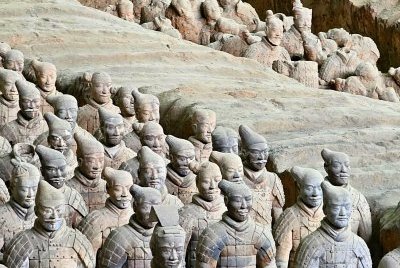
Visited in June 2024. As most visitors, we also visited only the Terracotta Army during our visit to Xi'an and skipped the actual mausoleum site. We arrived to the Terracotta Army site by a taxi which we took from Xi'an. The drive takes quite long so it isn't much faster option than taking the bus from Xi'an. We had bought the tickets online so there was no need to queue for tickets. As it was Saturday the site was very busy with Chinese tourists. The information signs around the entrance showed that this Terracotta Army site is just a small section of the whole mausoleum and there were signs towards the actual mausoleum, if you want to walk over there. We were only visiting the army as the weather was way too hot to walk over the mausoleum site.
From the entrance gate you have option to either walk to the museum site or take a shuttle bus. The walk isn't long so I wouldn't waste my time waiting for the shuttle. The actual museum area is divided in 4 buildings that you can visit. The famous Terracotta Army, which you see in all the photos, is located in the largest building, Hall 1, which is located right opposite the entrance. However, as we were hungry, we went first to eat and then decided to check out the exhibition halls from the smallest to the biggest. By the way, don't waste your time eating inside the museum area unless …
Keep reading 0 comments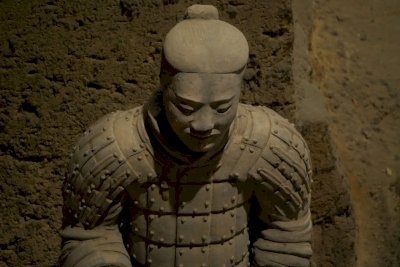
On my last visit to China in early 2020, I finally managed to see the Terracotta Army. The scale of the site is hard to fathom. When you are standing in front of the main host, it really feels like you are facing an army, a ghost army from the past. And then you go around and there are so many unique details to explore on each statue. Each of the 8.000 statues on its own would feature prominently in a Western museum. It's weird to think about it that a ruler would spend this much time and effort on a fake army. But the result is incredible.
Why not five stars, you may wonder? I think the site is not large enough to warrant five stars. It's an afternoon visit, nothing to dive into for multiple days.
Getting There
There are plenty of busses to take from Xian. You can find direction at chinatravelguide. However, the two connections I took aren't listed it seems. Coming from Xian airport I connected by bus to east Xi'an and took a local bus. Quite fun. On my return, I used a tourist bus shuttle going to Xi'an train station. Be aware, that the mausoleum is a mass tourism site, organized very efficiently and very Chinese.
While You Are There
I am a glowing fan of Xian. The city contains several silk road sites and several well deserving tentative sites (the walls, the mosque). Being an imperial …
Keep reading 0 comments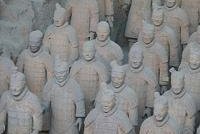
I visited this WHS in October 2013. I went as early as possible to the pits, yet still there were already lots of groups of tourists and locals. This meant that it was quite difficult to take photos in the central part of pit 1 but with some patience I managed to get some good close-ups, while the sun rays randomly lit some of the warriors' faces up. The sidewalks of pit 1 were much more easy to enjoy and the same applies to pits 2 and 3. The bronze chariots and the individual warriors displayed here are in great condition. Apart from the terracotta warriors, Xi'an has quite a lot to offer (neverending city walls, bell tower, drum tower, wild goose pagoda, muslim quarter, etc).
Keep reading 0 commentsKyle Magnuson
Grand Funerary Monument of a Short-lived Dynasty
Mausoleum of the First Qin Emperor (Inscribed)
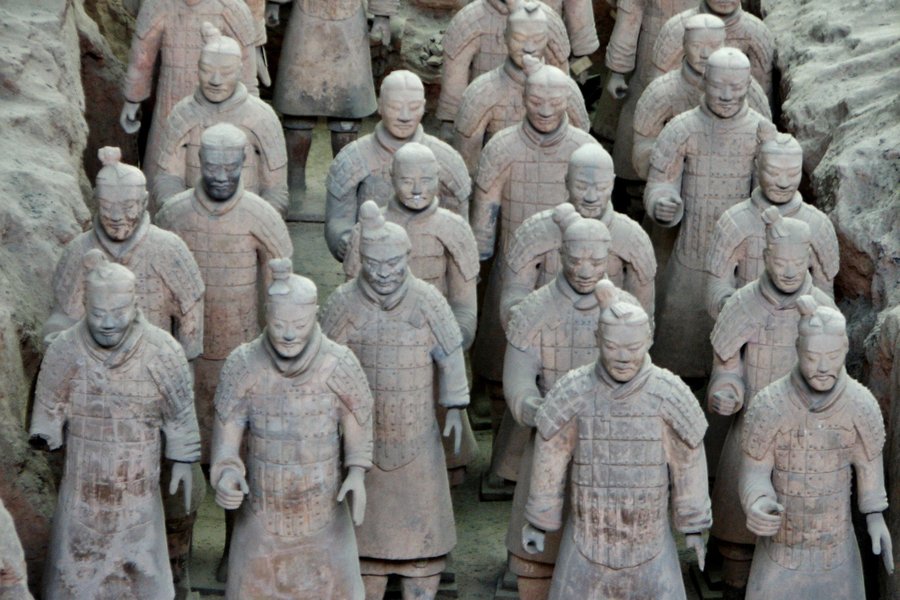
The highlight of any trip to Xi'an, the world famous Terra Cotta Warriors and Horses are magnificent to behold. The only downside is the sites are relatively quick to "view" and then you are basically on your way. Part of the sites OUV is connected to the detailed armory, weaponry, and dress. I did take time admiring the chariots, horses and various types of warriors. Photography is best with a zoom lens.
Xi'an is a city of contrasts, an incredibly dynamic and beautiful history, yet also at the same time rapidly modernizing. The City Wall is enormous and part of a serial tentative nomination that may one day be inscribed. Numerous properties inside and outside the city are now part of the "Silk Road" world heritage site.
My imagination of Xi'an, the capital of Han and Tang China was infused by that lofty history. Yet, modern China is defined by rapid development. Thus the sounds of construction and the sight of numerous cranes are to be expected.
Xi'an does reveal its rich history, the Mausoleum only discovered in the 1970's is well-known and essential to any visit to the city, but the city offers much more. Where Beijing is a city defined by the Yuan, Ming, and Qing Dynasties, Xi'an is defined by the Qin, Han, and Tang Dynasties. To better understand the cities history, the Shaanxi History Museum is a good start.
Keep reading 0 comments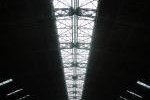
Forgotten for more than 2,000 years until accidentally rediscovered in 1974, Qin Bingmayong or famously known in English “the Qin Terracotta Army” was maybe the second most famous world heritage site of China after the Great Wall, strangely that both sites were built by the order of the same man, Qin Shi Huang, the first emperor of unified Chinese Empire.
Another long bus journey from Xi’an train station, the tourist bus took me to the city of Lintong famous for its local persimmon and where Qin Bingmayong was located. After Longmen, I was not surprised to find another tourist complex welcomed me, but this one was bigger and more commercialized with American fast-food shops and mini army of souvenir factories. Later I found out that there was electric car service that directly transported you to the inner gate of Qin Bingmayong skipping those entire crazy things!
Qin Bingmayong was the large complex of four modern exhibition halls as the Chinese had nicely transformed this archaeological site to be a well displayed museum. The largest look liked gym building or called pit 1 was where the famous terracotta army situated, under the protective roof the image of countless rows of clay soldiers and horses were astonishing, even though I had seen many pictures of this site before, I still surprised to see the real one, and I was overwhelmed by the grand size and the realistic faces of each soldier, I just wondered how could they did this amazing …
Keep reading 0 comments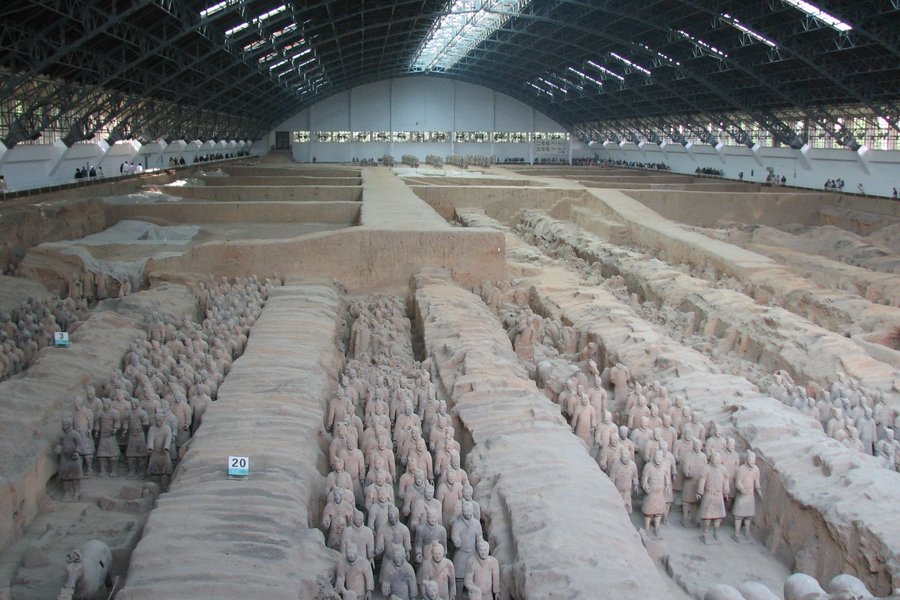
Xian's Terracotta Army belongs to the 10 or 20 most iconic sites that have been placed on the World Heritage List. Most people will have seen images of it. One can even come across some of these terracotta warriors outside of China: currently (2007-2008), a number of them are on display in a large exhibition at the British Museum in London. I saw a few myself last year in the Art Museum in Bonn, Germany. So what they look like is no surprise. To see them in their original surroundings, as the statues are left in situ, is another story.
Although I had been in Xian already for a couple of days, I had deliberately chosen early Monday morning as the time of my visit: the quietest time of the week that I could think of. And I proved to be right as I had plenty of freedom to look around and take pictures. I've read somewhere that the site can see 50.000 visitors on a busy day. For me personally, after weeks of visiting Chinese WHS as one of the few foreigners, it was remarkable to notice that Western visitors almost outnumber the Chinese here.
After watching the elementary explanation video, I started my round at Pit 3. This is believed to have been the army headquarters. It has only a few statues, but all the features, including horses. Wandering here, I realized that these statues weren't found intact; a lot of them were (and are) just bits and …
Keep reading 0 comments
Most people just fly into Xian, see the terra cotta soldiers and leave,for which they miss a lot. It's like seeing only the Sphinx and being finished with Egypt.
Xian had been the capital of China for over 2,000 years under various rulers/kingdoms. Therefore there are a lot more to see than just the terra cotta soldiers. The Xian provincial museum (30 RMB) is well worth two hours to learn enough history to put the Mausoleum in context. A side trip on the way to the airport would be the newly (02) finished museum housing the burial items (thousands)of Han Jingdi, in which the soldiers are one-third size, along with a large group of civil servants and the entire court; farmers and farm animals, etc. This was an involuntary excavation discovered when they were building the road to airport. Give you a sense of the incredible amount of stuff yet to be uncovered. I would skip the trips to the Buddahist temples and towers (although they are 1,300 years old), unless you are into the religion, and go for the Forest of Stele. The muslim street is worth a trip even if you are squeamish about the food. The muslim population and their wares evokes the Middle East.
Keep reading 0 comments
The Terracotta Army itself is a truly wonderful site. Upon first glance the army in hall 1 appears to be interesting, but nothing amazing. After a few moments the astonishing scale of the site and the incredible detail of the work becomes clear. The longer you spend around the warriors the more impressed you become. At 90 yuan the site is good value, and you won't regret the hours spent wandering around the site.
The burial mound of Qin is 1.5km away and is unexcavated. It is of limited interest compared to the Terracotta army.
Keep reading 0 comments
